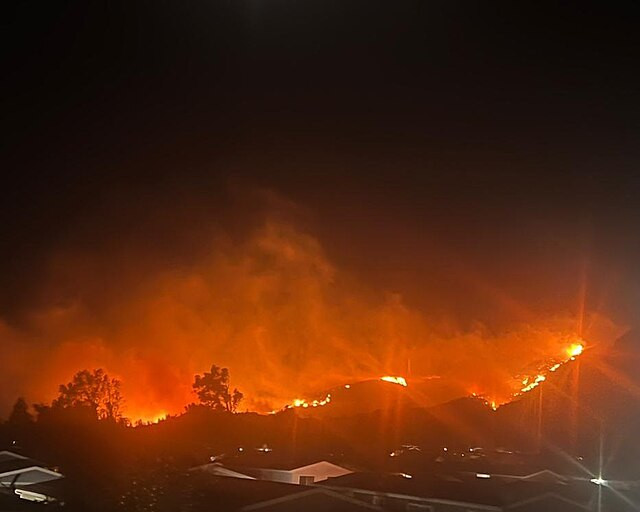A new analysis by JPMorgan Chase & Co. estimates that economic and insured losses from the devastating wildfires in Southern California could become the most costly in the state's history, exacerbating an already critical insurance crisis for homeowners.
JPMorgan's insurance analysts released a report Thursday highlighting the exposure of homeowners' and commercial property insurance lines due to the wildfires that have ravaged communities in the Los Angeles area, including Pacific Palisades and Altadena. At least five people have been killed, and over 2,000 homes, businesses, and other structures have been damaged or destroyed.
The report noted that nearly 30,000 acres have been impacted by the fires, with approximately 15,000 houses and buildings considered at risk as of Thursday-up from 13,000 just a day earlier. Firefighters have struggled to contain the wildfires, driven by strong Santa Ana winds, leading to increased concerns over potential losses.
"Expectations of economic losses stemming from the fires have more than doubled since yesterday to closer to $50 billion, and we estimate that insured losses from the event could exceed $20 billion (and even more if the fires are not controlled)," JPMorgan analysts wrote, according to Fox Business. "This would make this event significantly more severe than the 2018 Butte County Camp fires, the highest insured loss wildfires in California's history previously (with insured losses of roughly $10 billion)."
The 2018 Camp Fire, which devastated the town of Paradise and nearby communities, caused 85 fatalities and resulted in insured losses of about $10 billion. Most of the damage in that fire came from personal property losses, accounting for 86% of the total, compared to 12% for commercial property and 2% from other lines, including auto insurance.
The current wildfires are impacting larger population centers with higher property values. "While the current wildfires haven't affected as much acreage or as many houses/buildings (thus far), more of the damage is concentrated in the affluent Pacific Palisades area, which has high-value residential homes (median home price >$3 million versus <$500k in Butte County)," the JPMorgan report stated. "Moreover, the fires have not been contained thus far and continue to spread, implying that estimates of potential economic and insured losses are likely to increase."
The escalating losses come at a time when California is already grappling with an insurance crisis. Insurers have been pulling back from offering coverage in wildfire-prone areas, leaving homeowners scrambling for alternatives. Between 2020 and 2022, insurance companies declined to renew 2.8 million homeowner policies in the state, according to data from the California Department of Insurance. That includes 531,000 in Los Angeles County, where fires are currently raging.
State Insurance Commissioner Ricardo Lara acknowledged the severity of the problem. "We are being realistic about the risks in California," Lara told CNN on Wednesday. "We can never get to affordability unless we address the availability."
In an effort to tackle the crisis, the California Department of Insurance recently announced new regulations designed to encourage private insurers to write policies in fire-prone parts of the state. The rules require insurers to write policies in high-risk areas equal to at least 85% of their market share throughout the state. The policy also allows insurers to factor in the cost of reinsurance policies-insurance that companies buy from other firms to spread risk-into their rate calculations, a practice previously not permitted in California.
However, consumer advocacy groups have criticized the new regulations, arguing they could lead to significant premium increases without guaranteeing broader coverage. "This new policy is guaranteeing higher rates but not necessarily access to coverage," said Carmen Balber, executive director of Consumer Watchdog. "The commissioner has granted the insurance industry what it wants. There are so many loopholes and lack of teeth in the rule that homeowners won't see expanded coverage for a very long time, if at all."
The Insurance Information Institute, an industry trade group, supports the new rules, asserting that they are necessary for insurers to cover the high-risk market effectively. "We have seen the cost of reinsurance has been going up due to climate risk and also inflation," said Janet Ruiz, spokesperson for the institute. "California is the only state that hasn't allowed the cost of reinsurance to be factored into rates."
Homeowners like Lynne Levin-Guzman are feeling the impact firsthand. Standing in front of her 90-year-old parents' home in Los Angeles County, trying to protect it with a garden hose, she expressed frustration over their insurance cancellation. "They've lived in this house for 75 years and they've had the same insurance, and these insurance people decided to cancel their fire insurance," she told CNN affiliate KABC. "And they wonder why people leave California."
As more homeowners are forced to rely on the California FAIR Plan-a last-resort insurance provider with higher premiums and less coverage-the financial burden on residents is increasing. The FAIR Plan's exposure for dwellings as of September was up 61% to $458 billion from a year earlier, triple where it stood four years ago.
Despite assurances from the FAIR Plan that it can handle the influx of claims from the current fires, experts warn that homeowners will likely face higher premiums regardless of the outcome. "No matter the financial condition of FAIR after these fires, homeowners will almost certainly foot the bill in the form of higher premiums," CNN reported. "One way or another, it will probably become even more expensive to live in California."






